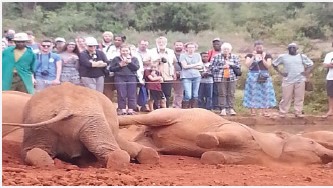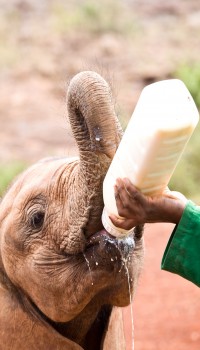We stepped off the plane at Nairobi International Airport late night. I had been excited throughout the flight to Kenya since it was the first time that I would step onto the continent of Africa. However, after nearly eight hours of flight, I was very tired and hardly noticed the streets we zipped through on the way to the hotel. Next morning, I woke up, all excited and raring to go. It was the first day of our 12-day tour of Kenya. That day, we were going to explore the delights that Nairobi had to offer. After an excellent continental breakfast served by a staff whose fluency in English was better than many of their ilk in India, we were ready for the day. The friendly hotel people had taught us the Kenyan greeting, Jambo. At the front door, our chauffer greeted us with a ‘Good morning’. We chorused back, ‘Jambo’ and received a wide grin from him. Nairobi is not a very big city and our first stop was the Elephant Orphanage at the David Sheldrick Wildlife Trust. Instituted by David Sheldrick, a conservationist, it shelters baby elephants that had been orphaned or hurt by trappers. It gave these calves a home, food, nurturing and medical aid until they became about three years old when they were reintroduced into the wild. At the time of our visit, there were about twenty-seven elephants in the orphanage. Located on the edge of Nairobi, the handlers at the Sheldrick Elephant Orphange, have been rescuing baby elephants for several decades. They pick up young elephants as young as two days old. When they find a young calf, at first, they try to find a female elephant nearby to nurse the baby. If none can be found or none will accept the baby, they bring the little elephant back to the shelter and feed, protect and care for it until it is about three years of age.
How does an elephant become an orphan?
There can be several reasons. It is possible that the mother may have been killed by lions, poachers or by a fall into a well or off a cliff. Sometimes, the mother may have simply abandoned the baby because it is sickly or, on rare occasions if the baby is a twin. When twin elephants are born, the mother will only accept one and will reject the other. At the same time, poaching, drought, habitat destruction, or human-wildlife conflict also lead to death of mothers. As infant elephants depend completely on their mother's milk for the first two years of their life, it is unlikely that orphaned babies could survive without human intervention.
Baby elephants must nurse until they are about three years old. In the wild, they are in a herd surrounded by nurturing female elephants until they are about 24 to 16 years old. Not only are young elephants nursed and nurtured, they are also kept warm at night by the collective body heat of the adults. When they are older, females stay with the herd and prepare to become mothers themselves. Males go off to live with the other bulls and are schooled in how to become daddy elephants.
The orphans in the shelter are deprived of herd care but their handlers are specially trained to look after them. They are fed from milk bottles about every three hours and brought into a corral where they are kept under blankets to stay warm. One handler stays with one baby elephant each night, but never the same handler with the same elephant more than once in the same week. They do this so that the babies do not develop an attachment to a particular human. There is a specific reason for this. Once the elephant is reintroduced into the wild, it is necessary that they retain their natural wariness of humans. However, years after being reintroduced, the elephants will remember the rescue workers and be friendly with them, but not with other humans.
The orphanage is open to the public for one hour a day, between 11 a.m. and midday. During this time, visitors have the opportunity to watch the babies being hand-fed by their keepers and enjoying a mud bath or soil dusting. The opportunity is both entertaining and educational. One of the keepers gives a fascinating lecture about the project's history and goals, the issues that face elephants in the wild and the practical problems of raising very young wild animals by hand. The babies are also introduced to the visitors along with their stories and personality traits.
We reached the orphanage at noon. Elephants in batches were brought into a corralled area. Big and small babies came trundling inside the enclosed area. They were in quite a hurry. They knew it was feeding time and were no different from hungry human toddlers who are completely focused on their milk bottles. Each handler held a three-litre plastic bottle with a huge nipple to the calf’s mouth. It contained a baby formula which was greedily sucked up in minutes. Each calf was given two bottles of milk. It was amusing to see how they grunted and squealed in protest if there was a little delay in the empty bottle being exchanged for a full one. They sounded so like the human baby whose milk bottle is taken away!
After guzzling milk, it was playtime. They rolled in heaps of red dust, happily spraying it over themselves with their trunks. Looking like mischievous schoolboys, they pushed each other, entwined their trunks and climbed on each other’s backs. The spectators on the other side of the ropes were told to maintain silence if an elephant came close to them. We were allowed to caress them, feel their rough skin and of course, click them.

When an elephant is ready to be reintroduced to the wild, the rescue workers locate a herd that they think will be suitable for the baby. Then they transport the baby to the area and bring it into the proximity of the herd.
But they don’t just leave at that point. They stay and observe from a distance for a few days. If the herd accepts the baby, they leave and check back only occasionally on the baby. If the baby is rejected, they will load up the baby elephant again and try with another herd. They repeat the process until they find a herd that will accept the orphan.
We found out that the centre does not only accept orphaned elephants. They also provide a home and play nursemaid to a baby rhinoceros. This particularly attractive chap gets to parade in front of visitors on a daily basis. The keepers told us that he too will be reintroduced to wild when he’s old enough.
As we sat back in our car to drive through the streets of Nairobi to our next park, the endearing sight of the baby elephants gambolling in the dust kept playing in my head. How trusting and innocent all young ones are until this world teaches them the harsh facts!
All Rights Reserved. Copyright@Sutapa Basu, 2017
